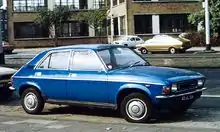Harris Mann
Harris Mann (born April 1938) is a British car designer.[1] Mann took over from Roy Haynes as chief stylist at British Leyland in 1970.

Biography
Harris Mann was born in London in 1938, and attended engineering school in Westminster. Mann's automotive design career started, first with the bus and coach building firm Duple, followed by a short time working in the U.S. with Loewy Consultancy. After a short spell of National Service back in the UK, Mann worked, first for Commer, then for Ford.
Cars on which Mann was involved at Ford included the first Escort and the Capri. Mann's boss at Ford, Roy Haynes, persuaded Mann to go with him when he moved to BMC to lead their design studio in Cowley in 1967.
Mann worked alongside Haynes on the BMC Marina project, and when the design department they were working in was relocated to Longbridge, Haynes left the company, leaving Mann to lead the design team for, what was by then, British Leyland (BL).
Mann took over the Allegro project, and then worked on the Diablo project, which became the Princess. This was followed by the work for which he is most famous, the Triumph TR7. His final projects with BL were the Metro. After these he left and went freelance. In this capacity he worked for MG Rover on the MG "Z" series (the ZR, ZS, and the ZT). He was also a design consultant for BMW in the mid 1980s, for which he was required to submit plans for a new corporate style and, in particular, to work on bonnet and boot shut lines and lights. According to Mann, "BMW shut lines were all over the place at that time". He proposed several designs to the BMW board including the double headlight design, very reminiscent of the Princess, which is still recognisable on BMW cars today.
Today, Mann is involved in independent design consultancy in the automotive sector, and is lecturing in design at Coventry University.
References
- "Harris Mann Interview". Classic Cars Magazine: 70–73. January 2005.
- "The Designer: Harris Man". Classic Car Weekly. December 2004.

